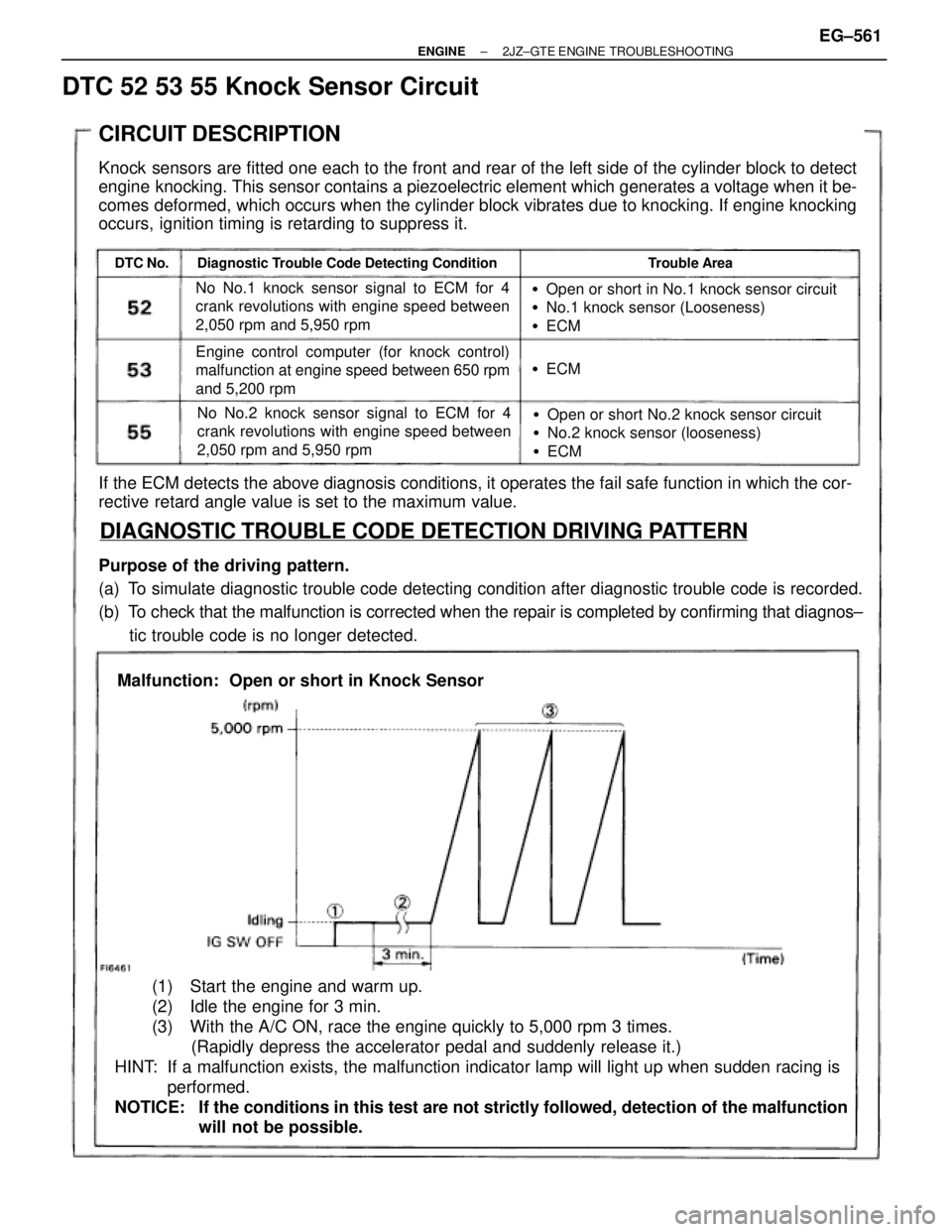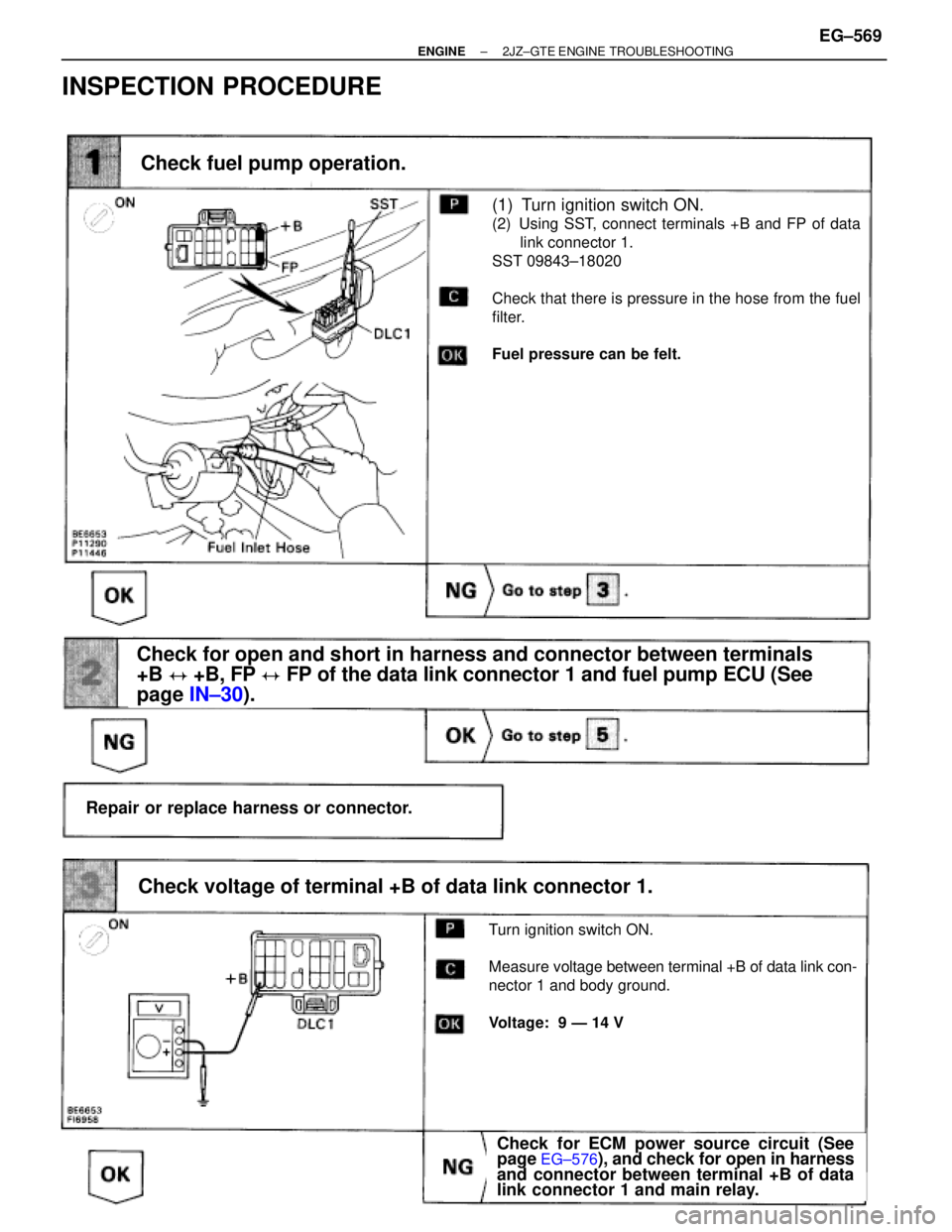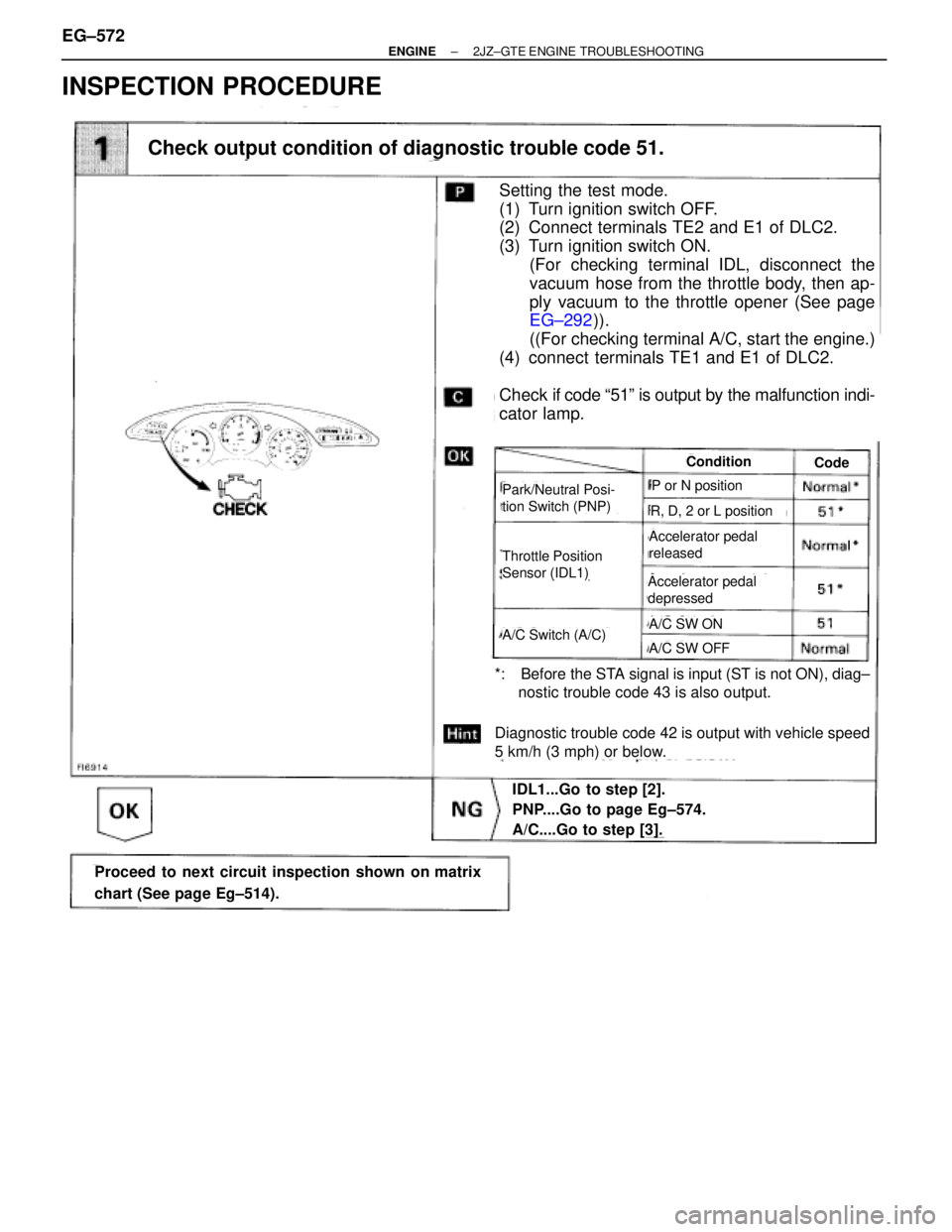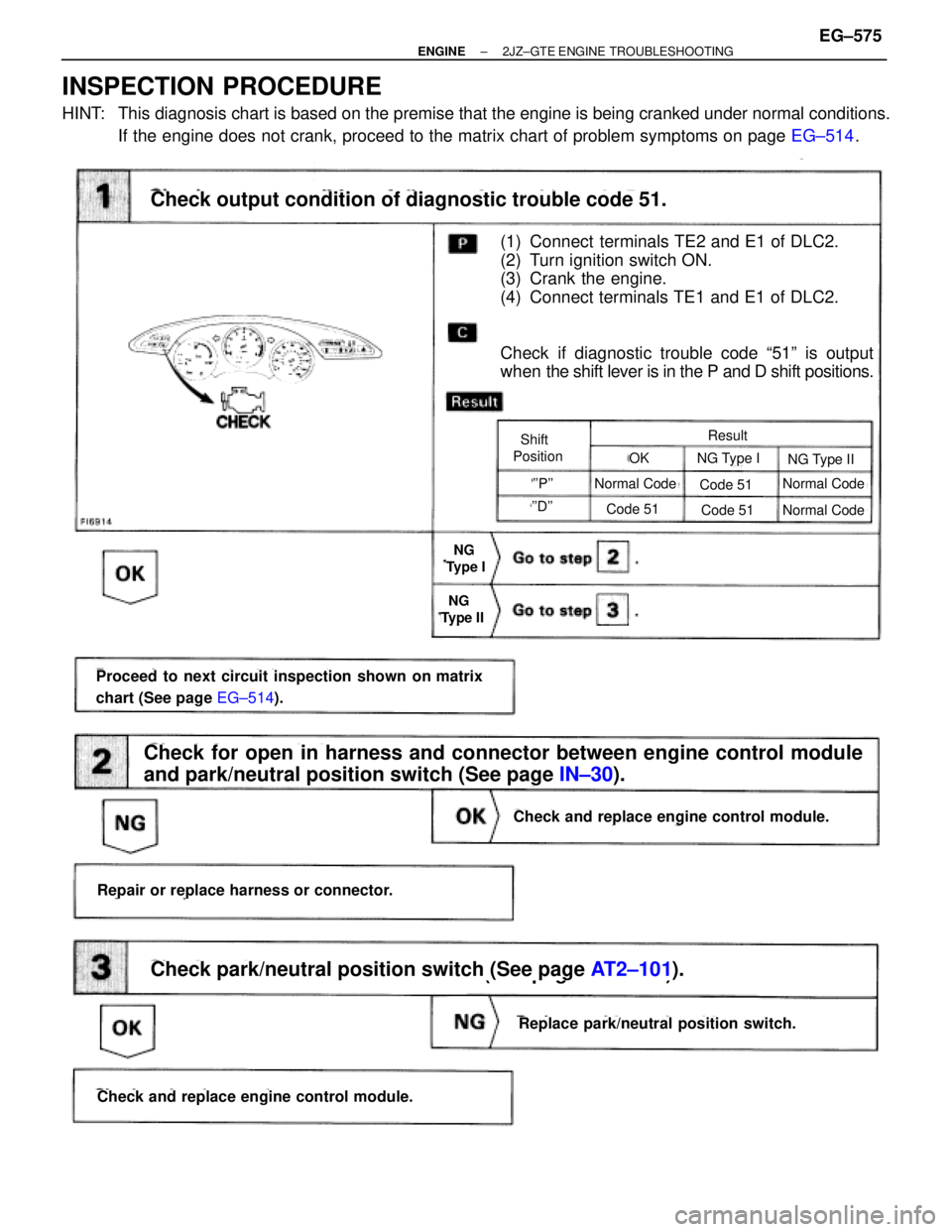Page 97 of 878
INSPECTION PROCEDURE
HINT: This diagnostic chart is based on the premise that the engine is being cranked under normal conditions.
If the engine does not crank, proceed to the matrix chart of problem symptoms on page EG±514.
(See page EG±514).
Setting the test mode.
(1) Turn ignition switch OFF.
(2) Connect terminals TE2 and E1 of DLC2.
(3) Turn ignition switch ON.
(Don't start the engine)
(4) Connect terminal TE1 and E1 of DLC2.
Check if code ª43º is output by the malfunction indi-
cator lamp.
Code ª43º is output.
Start the engine.
Check if code ª43º disappears.
Code ª43º is not output.
Check output condition of diagnostic trouble code 43.
Proceed to next circuit inspection shown on
matrix chart (See page Eg±514.)
Check and replace engine control module.
Check for open in harness and connector between engine control module
and starter relay (See page IN±30).
Repair or replace harness or connector.
EG±560± ENGINE2JZ±GTE ENGINE TROUBLESHOOTING
Page 98 of 878

DTC 52 53 55 Knock Sensor Circuit
CIRCUIT DESCRIPTION
Knock sensors are fitted one each to the front and rear of the left side of the cylinder block to detect
engine knocking. This sensor contains a piezoelectric element which generates a voltage when it be-
comes deformed, which occurs when the cylinder block vibrates due to knocking. If engine knocking
occurs, ignition timing is retarding to suppress it.
DTC No.Diagnostic Trouble Code Detecting ConditionTrouble Area
No No.1 knock sensor signal to ECM for 4
crank revolutions with engine speed between
2,050 rpm and 5,950 rpm
Engine control computer (for knock control)
malfunction at engine speed between 650 rpm
and 5,200 rpm
No No.2 knock sensor signal to ECM for 4
crank revolutions with engine speed between
2,050 rpm and 5,950 rpm
�Open or short in No.1 knock sensor circuit
�No.1 knock sensor (Looseness)
�ECM
�ECM
�Open or short No.2 knock sensor circuit
�No.2 knock sensor (looseness)
�ECM
If the ECM detects the above diagnosis conditions, it operates the fail safe function in which the cor-
rective retard angle value is set to the maximum value.
Purpose of the driving pattern.
(a) To simulate diagnostic trouble code detecting condition after diagnostic trouble code is recorded.
(b) To check that the malfunction is corrected when the repair is completed by confirming that diagnos±
tic trouble code is no longer detected.
DIAGNOSTIC TROUBLE CODE DETECTION DRIVING PATTERN
Malfunction: Open or short in Knock Sensor
(1) Start the engine and warm up.
(2) Idle the engine for 3 min.
(3) With the A/C ON, race the engine quickly to 5,000 rpm 3 times.
(Rapidly depress the accelerator pedal and suddenly release it.)
HINT: If a malfunction exists, the malfunction indicator lamp will light up when sudden racing is
performed.
NOTICE: If the conditions in this test are not strictly followed, detection of the malfunction
will not be possible.
± ENGINE2JZ±GTE ENGINE TROUBLESHOOTINGEG±561
Page 106 of 878

(See page IN±30).
Check for ECM power source circuit (See page
EG±576), and check for open in harness and
connector between terminal +B of data link
connector 1 and main relay.
(1) Turn ignition switch ON.
(2) Using SST, connect terminals +B and FP of data
link connector 1.
SST 09843±18020
Check that there is pressure in the hose from the fuel
filter.
Fuel pressure can be felt.
Check fuel pump operation.
Repair or replace harness or connector.
Check for open and short in harness and connector between terminals
+B � +B, FP � FP of the data link connector 1 and fuel pump ECU (See
page IN±30).
Turn ignition switch ON.
Measure voltage between terminal +B of data link con-
nector 1 and body ground.
Voltage: 9 Ð 14 V
Check voltage of terminal +B of data link connector 1.
Check for ECM power source circuit (See
page EG±576), and check for open in harness
and connector between terminal +B of data
link connector 1 and main relay.
INSPECTION PROCEDURE
± ENGINE2JZ±GTE ENGINE TROUBLESHOOTINGEG±569
Page 109 of 878

INSPECTION PROCEDURE
PNP...Go to page EG±574.
(See page EG±514).
Setting the test mode.
(1) Turn ignition switch OFF.
(2) Connect terminals TE2 and E1 of DLC2.
(3) Turn ignition switch ON.
(For checking terminal IDL, disconnect the
vacuum hose from the throttle body, then ap-
ply vacuum to the throttle opener (See page
EG±292)).
((For checking terminal A/C, start the engine.)
(4) connect terminals TE1 and E1 of DLC2.
Check if code ª51º is output by the malfunction indi-
cator lamp.
*: Before the STA signal is input (ST is not ON), diag±
nostic trouble code 43 is also output.
Diagnostic trouble code 42 is output with vehicle speed
5 km/h (3 mph) or below.
Check output condition of diagnostic trouble code 51.
IDL1...Go to step [2].
PNP....Go to page Eg±574.
A/C....Go to step [3].
Proceed to next circuit inspection shown on matrix
chart (See page Eg±514).
Check output condition of diagnostic trouble code 51.
Throttle Position
Sensor (IDL1)
Condition
Park/Neutral Posi-
tion Switch (PNP)
Code
Accelerator pedal
released
Accelerator pedal
depressed
A/C SW ON
A/C SW OFFA/C Switch (A/C)
P or N position
R, D, 2 or L position
EG±572± ENGINE2JZ±GTE ENGINE TROUBLESHOOTING
Page 112 of 878

INSPECTION PROCEDURE
HINT: This diagnosis chart is based on the premise that the engine is being cranked under normal conditions.
If the engine does not crank, proceed to the matrix chart of problem symptoms on page EG±514.
(See page EG±514).
(See page IN±30).
(See page AT2±101).
(1) Connect terminals TE2 and E1 of DLC2.
(2) Turn ignition switch ON.
(3) Crank the engine.
(4) Connect terminals TE1 and E1 of DLC2.
Check if diagnostic trouble code ª51º is output
when the shift lever is in the P and D shift positions.
Check output condition of diagnostic trouble code 51.
Check for open in harness and connector between engine control module
and park/neutral position switch (See page IN±30).
Check and replace engine control module.
Proceed to next circuit inspection shown on matrix
chart (See page EG±514).
Repair or replace harness or connector.
Replace park/neutral position switch.
Check and replace engine control module.
Check park/neutral position switch (See page AT2±101).
Shift
PositionResult
NG Type ING Type II
Normal CodeNormal Code
Normal CodeCode 51
Code 51
Code 51
''P''
''D''
OK
NG
Type I
NG
Type II
± ENGINE2JZ±GTE ENGINE TROUBLESHOOTINGEG±575
Page 113 of 878
ECM Power Source Circuit
CIRCUIT DESCRIPTION
When the ignition switch is turned on, battery volt-
age is applied to the terminal IGSW of the ECM,
and the main relay control circuit in the ECM sends
a signal to the terminal M±REL of the ECM, switch-
ing on the main relay. This signal causes current to
flow to the coil, closing the contacts of the main
relay and supplying power to the terminal + B of the
ECM.
If the ignition switch is turned off, the ECM contin-
ues to switch on the main relay for a maximum of
2 seconds for the initial setting of the IAC valve. EG±576
± ENGINE2JZ±GTE ENGINE TROUBLESHOOTING
Page 114 of 878
(See page EG±510)
(1) Connect SST (check harness ªAº).
(See page EG±510)
SST 09990±01000
(2) Turn ignition switch ON.
Measure voltage between terminal +B and E1 of
engine control module connector.
Voltage: 9 Ð 14 V
Check voltage between terminal +B and E1 of engine control module
connector.
Proceed to next circuit inspection shown on
matrix chart (See page EG±514).
Repair or replace harness or connector.
Check for open in harness and connector between terminal E1 of engine
control module and body ground (See page IN±30).
Turn ignition switch ON.
Measure voltage between terminal IGSW of en-
gine control module connector and body ground.
Voltage: 9 Ð 14 V
Check voltage between terminal IGSW of engine control module connector
and body ground.
INSPECTION PROCEDURE
± ENGINE2JZ±GTE ENGINE TROUBLESHOOTINGEG±577
Page 115 of 878
Check for short in the harness and all the compo-
nents connected to IGN fuse (See Electrical Wir-
ing Diagram).
Remove IGN fuse from J/B No.1.
Check continuity of IGN fuse.
Continuity
Check IGN fuse.
Check ignition switch.
(1) Remove finish lower panel and finish lower
panel LH.
(2) Remove heater to register duct No.2.
Check continuity between terminals.
Check and repair harness and connector between
battery and ignition switch, ignition switch and en-
gine control module.
Replace ignition switch.
Terminal
Switch position
LOCK
ACC
ON
START
continuity
EG±578± ENGINE2JZ±GTE ENGINE TROUBLESHOOTING